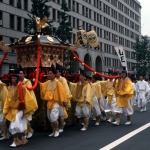Sanno Matsuri
A procession of 300 people dressed in ancient costumes parades through the heart of Tokyo.
Event Information
Place: Hie-jinja Shrine
Dates: June 6th - 17th
City: Nagata-cho, Chiyoda-ku, Tokyo
The Sanno Matsuri is famous as a festival permitted by the Shogun to enter the grounds of Edo Castle during the Edo Period (1603-1867), along with the Kanda Matsuri. It is also one of the three largest festivals of Japan. The main procession called jinkosai takes place in the middle of June in every other year according to the Western calendar.
About 300 people dressed in ancient costumes parade through the heart of Tokyo including Tokyo Station, Ginza, and in front of the Diet Building. Consisting of mikoshi (portable shrines) adorned with a phoenix on the roof, dashi floats, people carrying drums, people on horseback, the procession extends over a length of 600 meters. You will also see people dressed as the legendary goblin called Tengu, characterized by a red face and a long nose, and believed to possess supernatural powers. The procession which departs from Hie-jinja Shrine at 8 o'clock in the morning does not return to the shrine until early in the evening.
A procession of 300 people dressed in ancient costumes parades through the heart of Tokyo.
Event Information
Place: Hie-jinja Shrine
Dates: June 6th - 17th
City: Nagata-cho, Chiyoda-ku, Tokyo
The Sanno Matsuri is famous as a festival permitted by the Shogun to enter the grounds of Edo Castle during the Edo Period (1603-1867), along with the Kanda Matsuri. It is also one of the three largest festivals of Japan. The main procession called jinkosai takes place in the middle of June in every other year according to the Western calendar.
About 300 people dressed in ancient costumes parade through the heart of Tokyo including Tokyo Station, Ginza, and in front of the Diet Building. Consisting of mikoshi (portable shrines) adorned with a phoenix on the roof, dashi floats, people carrying drums, people on horseback, the procession extends over a length of 600 meters. You will also see people dressed as the legendary goblin called Tengu, characterized by a red face and a long nose, and believed to possess supernatural powers. The procession which departs from Hie-jinja Shrine at 8 o'clock in the morning does not return to the shrine until early in the evening.
Nidhi KM
- Heian Jingu Shrine

No comments:
Post a Comment